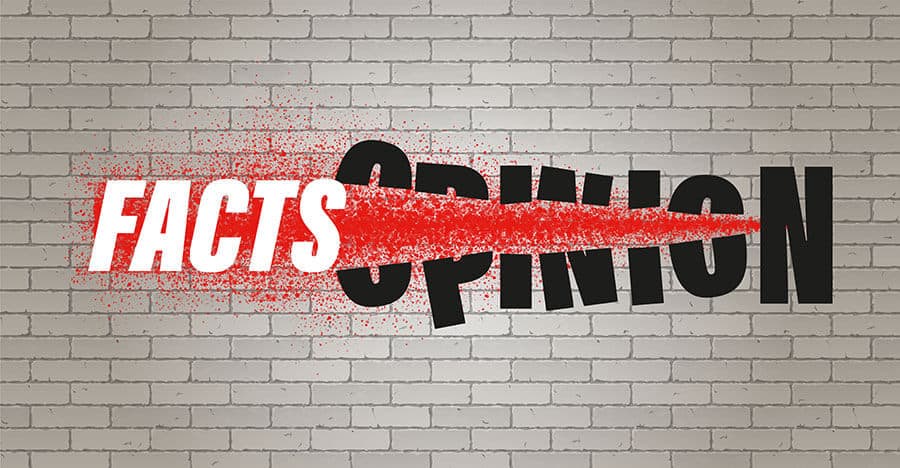If only it were easy to tell what’s a fact and what’s an opinion. In a world where anyone can become a source of news through social media and the Internet, it is getting increasingly hard to identify trustworthy information. Read on to learn the differences between facts and opinion and see which media outlets will mostly provide you with factual information as opposed to personal views so that you can make more informed decisions when forming your own opinion.
Facts VS Opinion: Most incoming information nowadays comes from two categories: conventional sources and digital outlets. Conventional sources include TV, radio, and newspapers, which have been around the longest, whereas digital outlets include podcasts, social media and websites.
News reports on TV and radio as well as news outlets online tend to portray information as it is and provide the most factual information.
Social media, blogs and talk shows, on the other hand, are a platform for opinion and bias. With that said, according to a recent study, 73 percent of Europeans aged 18-24 get their news online.
Almost 90 percent of those aged 50 and older will turn to TV for the news.
As digital media blur the lines between what is fact and what is opinion, it is crucial to access incoming information critically.
How to distinguish fact from opinion
Facts consist of proven information that is consistent with objective reality. Facts are based on observation and can be proven true with evidence with multiple sources.
Factual statements contain numbers, names, locations and dates as well as links to sources to help back them up.
On the other hand, an opinion is subject to one’s beliefs, is based on emotions, and cannot be confirmed.
Opinions also tend to be biased towards a particular position and are great for learning different perspectives.
As a rule of thumb, opinion signals include the use of 1st and 2nd person (I, we, you), superlatives (best, worst), modal verbs (might, should, must), exaggeration, and a sarcastic tone.
Test yourself: fact vs opinion
Although there are typical features for facts and opinion, the lines between these two terms are blurred due to the absence of uniform guidelines and checks in the media.
To show how easy it is to mistake facts for opinion, The Pew Research Center has created a simple test.
The quiz consists of 10 statements which can be categorized as factual information or statements of opinion.

The Pew Research Centre is an American think tank based in Washington, D.C., that provides information on social issues, public opinion, and demographic trends.
And according to the report, based on the results of this quiz, only a quarter of Americans managed to classify all five facts and 35% of participants correctly chose the opinion sentences.
What does that mean?
That means that many people take opinions as true sources of information, and that can lead to spreading misinformation.
In order to evaluate information more critically when stumbling upon it, here are a few tips to keep in mind.
Determine the type of content
Whether you are getting your daily news online or using conventional outlets, first determine whether the source of information is actually reliable. Is it an opinion piece that you are reading or a news report?
Is it a paid article produced by a company, or is it someone’s thoughts on a certain topic?

Certain websites, e.g. The Onion, are so-called satirical websites. They cover current events both real and fictional with the layout of a traditional news website. This can sometime fool international audiences.
Check the Author
Whether you’re following a blogger or reading an editorial on a news website, the writer’s credentials and background can determine whether he or she is an expert in the field.
A quick Google search can reveal the author’s work. It can help to determine if the writer is biased towards a position or has extreme views.
Beware of Social Media algorithms
In 2020, Facebook feed shows your posts based on three main criteria: who your contacts are, the type of content (photo, video, link, etc.) you interact with the most, and the popularity of the post.
This is intended to bring about a positive reaction in you and increase the time you spend on the platform.
But another outcome of these algorithms can be to form an echo chamber in social media.
This can lead to seeing only the opinions of like-minded people, which reinforces the individual’s belief system.
Photos: Shutterstock / graphic design: Martina Advaney
Read more here.
Behind the Curtains: The Burdens of Reporting During a Pandemic
Support us!
All your donations will be used to pay the magazine’s journalists and to support the ongoing costs of maintaining the site.
Share this post
Interested in co-operating with us?
We are open to co-operation from writers and businesses alike. You can reach us on our email at cooperations@youthtimemag.com/magazine@youthtimemag.com and we will get back to you as quick as we can.










